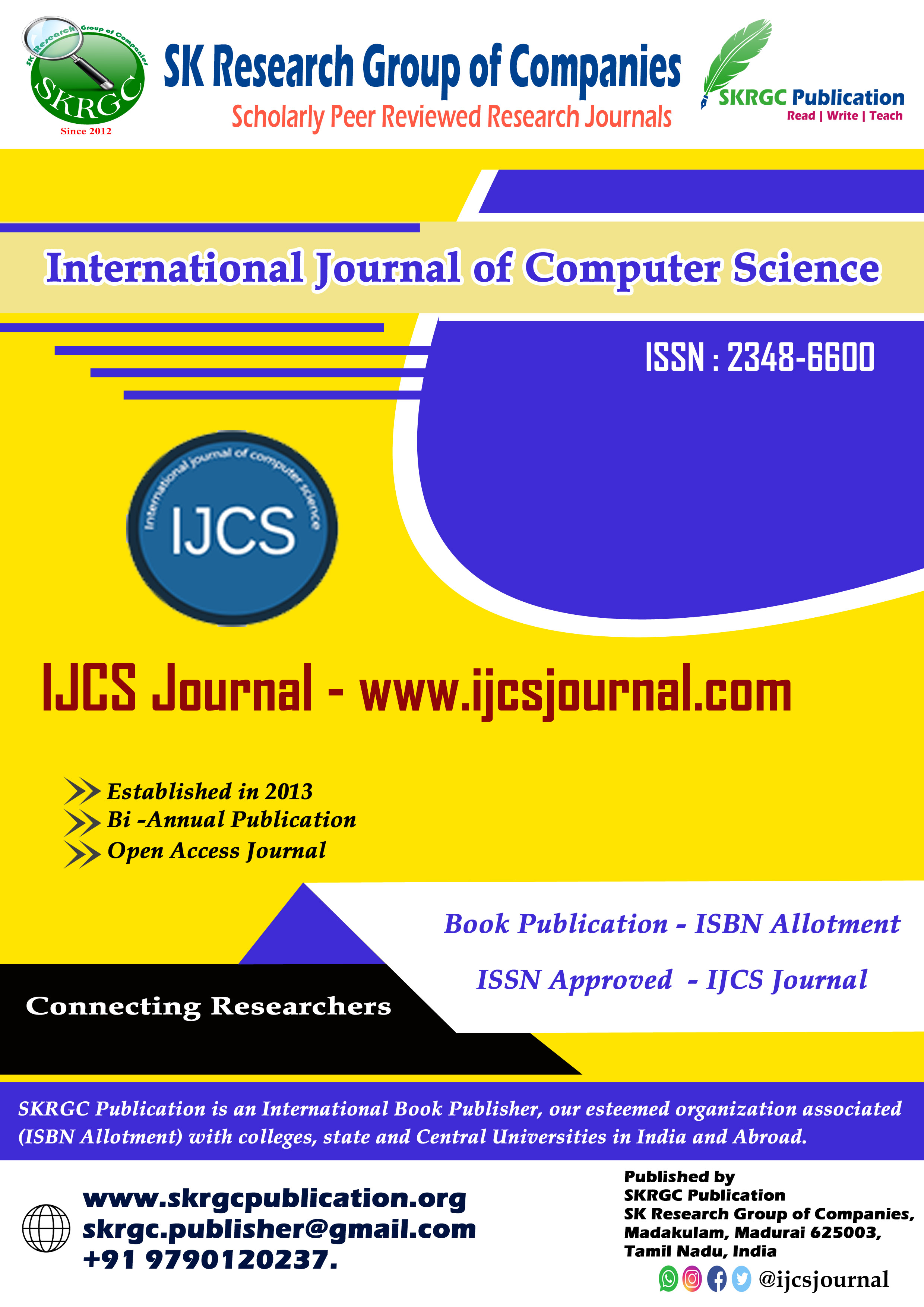The Method of Probabilistic Nodes Combination in Bionics
International Journal of Computer Science (IJCS) Published by SK Research Group of Companies (SKRGC)
Download this PDF format
Abstract
Proposed method, called Probabilistic Nodes Combination (PNC), is the method of 2D curve modeling and handwriting identification by using the set of key points. Nodes are treated as characteristic points of signature or handwriting for modeling and writer recognition. Identification of handwritten letters or symbols need modeling and the model of each individual symbol or character is built by a choice of probability distribution function and nodes combination. PNC modeling via nodes combination and parameter ? as probability distribution function enables curve parameterization and interpolation for each specific letter or symbol. Two-dimensional curve is modeled and interpolated via nodes combination and different functions as continuous probability distribution functions: polynomial, sine, cosine, tangent, cotangent, logarithm, exponent, arc sin, arc cos, arc tan, arc cot or power function.
References
1. Schlapbach, A., Bunke, H.: Off-line writer identification using Gaussian mixture models. In: International Conference on Pattern Recognition, pp. 992–995 (2006)
2. Bulacu, M., Schomaker, L.: Text-independent writer identification and verification using textural and allographic features. IEEE Trans. Pattern Anal. Mach. Intell. 29 (4), 701–717 (2007)
3. Djeddi, C., Souici-Meslati, L.: A texture based approach for Arabic writer identification and verification. In: International Conference on Machine and Web Intelligence, pp. 115–120 (2010)
4. Djeddi, C., Souici-Meslati, L.: Artificial immune recognition system for Arabic writer identification. In: International Symposium on Innovation in Information and Communication Technology, pp. 159–165 (2011)
5. Nosary, A., Heutte, L., Paquet, T.: Unsupervised writer adaption applied to handwritten text recognition. Pattern Recogn. Lett. 37 (2), 385–388 (2004)
6. Van, E.M., Vuurpijl, L., Franke, K., Schomaker, L.: The WANDA measurement tool for forensic document examination. J. Forensic Doc. Exam. 16, 103–118 (2005)
7. Schomaker, L., Franke, K., Bulacu, M.: Using codebooks of fragmented connected-component contours in forensic and historic writer identification. Pattern Recogn. Lett. 28 (6), 719–727 (2007)
8. Siddiqi, I., Cloppet, F., Vincent, N.: Contour based features for the classification of ancient manuscripts. In: Conference of the International Graphonomics Society, pp. 226–229 (2009)
9. Garain, U., Paquet, T.: Off-line multi-script writer identification using AR coefficients. In: International Conference on Document Analysis and Recognition, pp. 991–995 (2009)
10. Bulacu, M., Schomaker, L., Brink, A.: Text-independent writer identification and verification on off-line Arabic handwriting. In: International Conference on Document Analysis and Recognition, pp. 769–773 (2007)
11. Ozaki, M., Adachi, Y., Ishii, N.: Examination of effects of character size on accuracy of writer recognition by new local arc method. In: International Conference on Knowledge-Based Intelligent Information and Engineering Systems, pp.1170–1175 (2006)
12. Chen, J., Lopresti, D., Kavallieratou, E.: The impact of ruling lines on writer identification. In: International Conference on Frontiers in Handwriting Recognition, pp. 439–444 (2010)
13. Chen, J., Cheng, W., Lopresti, D.: Using perturbed handwriting to support writer identification in the presence of severe data constraints. In: Document Recognition and Retrieval, pp. 1–10 (2011)
14. Galloway, M.M.: Texture analysis using gray level run lengths. Comput. Graphics Image Process. 4 (2), 172–179 (1975)
15. Siddiqi, I., Vincent, N.: Text independent writer recognition using redundant writing patterns with contour-based orientation and curvature features. Pattern Recogn. Lett. 43 (11), 3853–3865 (2010)
16. Ghiasi, G., Safabakhsh, R.: Offline text-independent writer identification using codebook and efficient code extraction methods. Image and Vision Computing 31, 379–391 (2013)
17. Shahabinejad, F., Rahmati, M.: A new method for writer identification and verification based on Farsi/Arabic handwritten texts, Ninth International Conference on Document Analysis and Recognition (ICDAR 2007), pp. 829–833 (2007)
18. Schlapbach, A., Bunke, H.: A writer identification and verification system using HMM based recognizers, Pattern Anal. Appl. 10, 33–43 (2007)
19. Schlapbach, A., Bunke, H.: Using HMM based recognizers for writer identification and verification, 9th Int. Workshop on Frontiers in Handwriting Recognition, pp. 167–172 (2004)
20. Marti, U.-V., Bunke, H.: The IAM-database: an English sentence database for offline handwriting recognition, Int. J. Doc. Anal. Recognit. 5, 39–46 (2002)
21. Collins II, G.W.: Fundamental Numerical Methods and Data Analysis. Case Western Reserve University (2003)
22. Chapra, S.C.: Applied Numerical Methods. McGraw-Hill (2012)
23. Ralston, A., Rabinowitz, P.: A First Course in Numerical Analysis – Second Edition. Dover Publications, New York (2001)
24. Zhang, D., Lu, G.: Review of ShapeRepresentation and Description Techniques. Pattern Recognition 1(37), 1-19 (2004)
25. Schumaker, L.L.: Spline Functions: Basic Theory. Cambridge Mathematical Library (2007)
26. Dahlquist, G., Bjoerck, A.: Numerical Methods. Prentice Hall, New York (1974)
27. Jakóbczak, D.: 2D and 3D Image Modeling Using Hurwitz-Radon Matrices. Polish Journal of Environmental Studies 4A(16), 104-107 (2007)
28. Jakóbczak, D.: Shape Representation and Shape Coefficients via Method of Hurwitz-Radon Matrices. Lecture Notes in Computer Science 6374 (Computer Vision and Graphics: Proc. ICCVG 2010, Part I), Springer-Verlag Berlin Heidelberg, 411-419 (2010)
29. Jakóbczak, D.: Curve Interpolation Using Hurwitz-Radon Matrices. Polish Journal of Environmental Studies 3B(18), 126-130 (2009)
30. Jakóbczak, D.: Application of Hurwitz-Radon Matrices in Shape Representation. In: Banaszak, Z., ?wi?, A. (eds.) Applied Computer Science: Modelling of Production Processes 1(6), pp. 63-74. Lublin University of Technology Press, Lublin (2010)
31. Jakóbczak, D.: Object Modeling Using Method of Hurwitz-Radon Matrices of Rank k. In: Wolski, W., Borawski, M. (eds.) Computer Graphics: Selected Issues, pp. 79-90. University of Szczecin Press, Szczecin (2010)
32. Jakóbczak, D.: Implementation of Hurwitz-Radon Matrices in Shape Representation. In: Chora?, R.S. (ed.) Advances in Intelligent and Soft Computing 84, Image Processing and Communications: Challenges 2, pp. 39-50. Springer-Verlag, Berlin Heidelberg (2010)
33. Jakóbczak, D.: Object Recognition via Contour Points Reconstruction Using Hurwitz-Radon Matrices. In: Józefczyk, J., Orski, D. (eds.) Knowledge-Based Intelligent System Advancements: Systemic and Cybernetic Approaches, pp. 87-107. IGI Global, Hershey PA, USA (2011)
34. Jakóbczak, D.: Curve Parameterization and Curvature via Method of Hurwitz-Radon Matrices. Image Processing & Communications- An International Journal 1-2(16), 49-56 (2011)
Keywords
Handwriting identification, shape modeling, curve interpolation, PNC method, nodes combination, probabilistic modeling.

